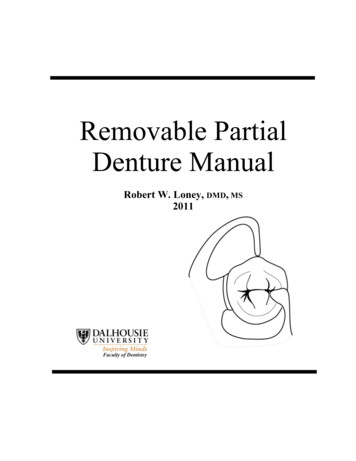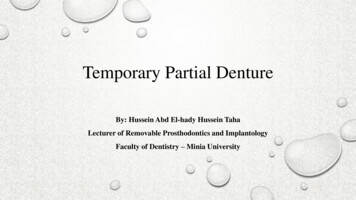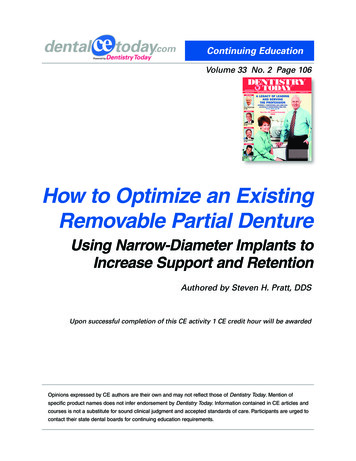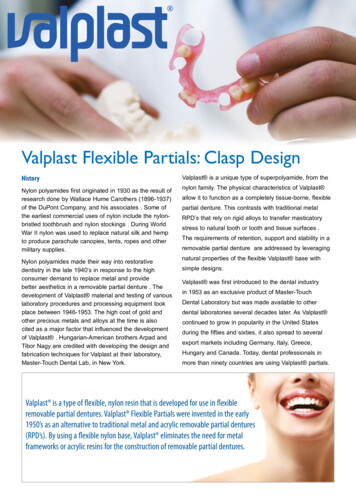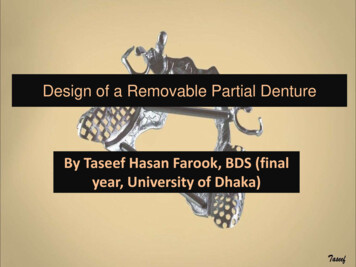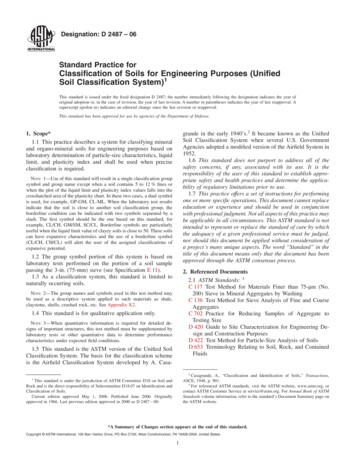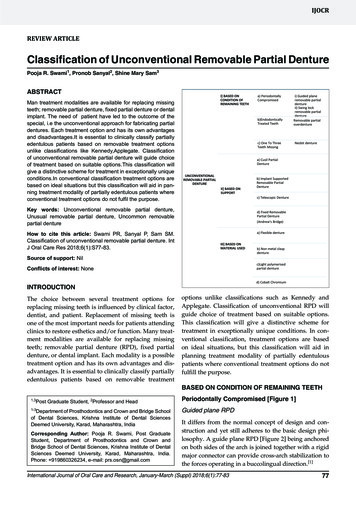
Transcription
IJOCRREVIEW ARTICLEClassification of Unconventional Removable Partial DenturePooja R. Swami1, Pronob Sanyal2, Shine Mary Sam3ABSTRACTMan treatment modalities are available for replacing missingteeth; removable partial denture, fixed partial denture or dentalimplant. The need of patient have led to the outcome of thespecial, i.e the unconventional approach for fabricating partialdentures. Each treatment option and has its own advantagesand disadvantages.It is essential to clinically classify partiallyedentulous patients based on removable treatment optionsunlike classifications like Kennedy,Applegate. Classificationof unconventional removable partial denture will guide choiceof treatment based on suitable options.This classification willgive a distinctive scheme for treatment in exceptionally uniqueconditions.In conventional classification treatment options arebased on ideal situations but this classification will aid in panning treatment modality of partially edentulous patients whereconventional treatment options do not fulfil the purpose.Key words: Unconventional removable partial denture,Unusual removable partial denture, Uncommon removablepartial dentureHow to cite this article: Swami PR, Sanyal P, Sam SM.Classification of unconventional removable partial denture. IntJ Oral Care Res 2018;6(1):S77-83.Source of support: NilConflicts of interest: NoneINTRODUCTIONThe choice between several treatment options forreplacing missing teeth is influenced by clinical factor,dentist, and patient. Replacement of missing teeth isone of the most important needs for patients attendingclinics to restore esthetics and/or function. Many treatment modalities are available for replacing missingteeth; removable partial denture (RPD), fixed partialdenture, or dental implant. Each modality is a possibletreatment option and has its own advantages and disadvantages. It is essential to clinically classify partiallyedentulous patients based on removable treatmentoptions unlike classifications such as Kennedy andApplegate. Classification of unconventional RPD willguide choice of treatment based on suitable options.This classification will give a distinctive scheme fortreatment in exceptionally unique conditions. In conventional classification, treatment options are basedon ideal situations, but this classification will aid inplanning treatment modality of partially edentulouspatients where conventional treatment options do notfulfill the purpose.BASED ON CONDITION OF REMAINING TEETH1,3Post Graduate Student, 2Professor and Head1-3Department of Prosthodontics and Crown and Bridge Schoolof Dental Sciences, Krishna Institute of Dental SciencesDeemed University, Karad, Maharashtra, IndiaCorresponding Author: Pooja R. Swami, Post GraduateStudent, Department of Prosthodontics and Crown andBridge School of Dental Sciences, Krishna Institute of DentalSciences Deemed University, Karad, Maharashtra, India.Phone: 919860326234, e-mail: prs.osn@gmail.comPeriodontally Compromised [Figure 1]Guided plane RPDIt differs from the normal concept of design and construction and yet still adheres to the basic design philosophy. A guide plane RPD [Figure 2] being anchoredon both sides of the arch is joined together with a rigidmajor connector can provide cross-arch stabilization tothe forces operating in a buccolingual direction.[1]International Journal of Oral Care and Research, January-March (Suppl) 2018;6(1):77-83 77
Swami, et al. Figure 1: Periodontally compromisedFigure 3: Swing-lock removable partial dentureFigure 4: Removable partial overdentureFigure 2: Guided plane removable partial dentureIndication-it aids in stabilization of teeth which areperiodontally compromised.Swing-lock RPD [Figure 3]The swing-lock RPD was introduced to the dental profession by Simmons in 1963.[2] It consists of labial/buccal retaining bar hinged at one end and locked with alatch at the other, together reciprocating lingual plate togain a maximum retention and stability.Indications1.2.3.4.5.Inadequate bone supportInadequate retentionMissing key abutmentsEconomicsMobility.Contraindications1. A swing-lock RPD should not be used for patientswho have poor oral hygiene2. Inadequate manual dexterity3. Deep vertical overbite with minimal horizontal overjet that does not permit a lingual plate for a maxillaryprosthesis4. Short lip or little vestibular depth which may allowthe labial bar and struts to be visible5. High frenal attachment, which will interfere with thelabial bar6. Prominent labial alveolar ridge with no labialundercut, which will not provide room for barplacement and will interfere with appearance andlip function.[3]Endodontically Treated TeethRemovable partial overdenture [Figure 4]According to GPT 9, overdenture is a removable partial or complete denture that covers and rests on oneor more remaining natural teeth, roots, and/or dentalimplants; a dental prosthesis that covers and is partiallysupported by natural teeth, tooth roots, and/or dentalimplants. It is also called as overlay denture, overlayprosthesis, and superimposed prosthesis.International Journal of Oral Care and Research, January-March (Suppl) 2018;6(1):77-83 78
IJOCR Classification of unconventional removable partial dentureIndication1. Patients with few remaining retainable teeth in anarch;2. Patients with mal-related ridge cases; patients needing single denture;3. Patients with unfavorable tongue positions, muscleattachments, and high palatal vault, which render thestability and retention of the prosthesis difficult. [4-6]Figure 5: Nesbit denturesContraindicationsPatients with questionable oral prophylaxis, systemic complications, and inadequate inter-arch distance.Advantages1. Preservation of alveolar bone, proprioception,enhanced stability, and retention and maintenanceof vertical dimension of occlusion.2. It is also useful for patients with congenital defectssuch as oligodontia, cleft palate, cleidocranial dysostosis, and Class III occlusion.3. Overdenture can be easily converted to completedenture over a period of time.4. Harmony of arch form.Disadvantages1.2.3.4.5.Caries culous oral hygiene is pertinent to prevent caries and periodontal disease6. Encroachment of interocclusal distance7. Expensive approach with frequent recall checkupsof the patient compared to conventional removablecomplete denture.[5-9]One–Three Teeth MissingNesbit denture [Figure 5]Nesbit dentures are a modification of conventionalRPDs used to replace one–three missing teeth on thesame side of the upper or lower arch. They providea low-cost option that employs newer technology toreplace missing teeth, whereby no metal clasps are fitted around supporting teeth on either side of the gap,to keep the denture from settling into your gum tissue.The result is a much smaller and more comfortable prosthetic compared to the standard partial denture.Nesbit dentures are mostly used as provisionalreplacement while patients await implant restoration,since there is no connecting metal or plastic behindthe lower front teeth, or across the roof of the mouth,Figure 6: Cu-Sil partial dentureto connect to the opposite side of the jaw. This meansthat there is no bilateral support from the other sides ofthe mouth to stop damaging forces from impacting theteeth supporting the Nesbit. Hence, it should be shortterm to avoid damaging adjacent teeth.Unfortunately, a serious risk of aspiration and swallowing exists due to its small size and limited retention. This danger can produce laceration, infection, andrequires hospitalization and surgical intervention.BASED ON SUPPORTCu-Sil Partial Denture [Fifure 6]Cu-Sil dentures are designed to preserve the very fewremaining natural teeth and thus the alveolar bone.They have effect on retention and stability of dentures.In addition to this, it gives the patient psychologicalsatisfaction of retaining the natural teeth as they were.Vertical dimension and proprioception are maintainedby retained natural teeth. Attachment devices areavoided entirely. Cu-Sil is a tissue-bearing appliancefeaturing a soft elastomeric gasket. It clasps the neck ofeach natural tooth, sealing out food and fluids, cushioning, and splinting each natural tooth from the hard denture base.[10] It helps to prevent tooth loss and improvesthe prognosis of loose, mobile, isolated, elongated, orperiodontally involved abutments by eliminating wear,stress, and torque. This treatment modality does notrequire any tooth preparation and extra patient visit.It does not require any special armamentarium andInternational Journal of Oral Care and Research, January-March (Suppl) 2018;6(1):77-83 79
Swami, et al. material. If a tooth is lost in future, existing denture canbe modified to occupy its place. They serve as a solution for single standing or isolated teeth present in dental arch. They are not indicated for patients with largenumber of teeth evenly distributed across the dentalarch. These dentures are associated with some disadvantages. The functional duration of soft liner used isshort for 3 years.Disadvantages1. It needs frequent corrections.2. Entire gingival margin of remaining teeth is covered,leading to plaque accumulation.[11]Implant-Supported RPD [Figure 7]The challenging problem with the use of conventionalRPDs is the distal rotation of the acrylic base in the freeend region of RPDs distal to the last natural tooth. Distalimplants effectively convert a Kennedy Class I or II denture to a Kennedy Class III denture. Due to the placement of an implant in a distal position, fewer implantsare needed to achieve a successful distal extension RPDwhile preventing alveolar ridge bone loss over time.[12]The use of dental implants has become widely accepted,and many studies have demonstrated that the association of RPDs with implants improves the prosthetic biomechanics, resulting in greater patient satisfaction.[13-15]Decades have now passed since implants and RPDs havebeen utilized in combination. It is also noteworthy todiscuss the cost differences associated with implant-assisted RPDs versus fixed prosthesis. Blum and McCordhave previously compared long-term costs of both systems and demonstrated that the use of implants in RPDsis seen as a less expensive option than fixed prosthesiswhere numerous implants would be required with necessary crowns over restorations.[16]that might dislodge the RPDs. Telescopic crowns can alsobe used as indirect retainers to prevent dislodgement ofthe distal extension base away from the edentulous ridge.Advantages[17,18]1.2.3.4.5.Creation of a common path of insertion.Easy to perform routine oral hygiene.Rigid splinting action.Distribution of stresses to the abutment teeth.Provision of suitable abutments for RPDs even whenthe remaining teeth are periodontally compromised.Much easier insertion and removal for the patient.Accommodates future changes in the treatmentplan. Psychologically well-tolerated by patients.Figure 7: Implant-supported removable partial dentureTelescopic Denture [Figure 8]Although first described by Starr in 1886, telescopic copings were initially introduced as retainers for RPDs at thebeginning of the 20th century. Due to its resemblance to thecollapsible optical telescope, this system of double crowns,which can be fitted into each other, became known asthe telescopic denture. Telescoping refers to the use of aprimary full-coverage casting (coping/male telescopicportion) luted to the prepared tooth with a secondary casting (superstructure/secondary crown/female telescopicportion), which is a part of the denture framework and isretained by means of interfacial surface tension over theprimary casting.[17,18] They act by transferring forces alongthe direction of the long axis of the abutment teeth and provide guidance, support, and protection from movementsFigure 8: Telescopic dentureFigure 9: Andrew’s bridgeInternational Journal of Oral Care and Research, January-March (Suppl) 2018;6(1):77-83 80
IJOCR DisadvantagesClassification of unconventional removable partial dentureDr. James Andrews of Amite, Louisiana, introduced thefixed removable Andrews Bridge System (Institute ofCosmetic Dentistry, Amite, La.).Flexible RPDs are practically indicated in every partialedentulous condition provided the patients are ready tokeep a removable appliance in his/her mouth. Flexibledenture contains polyamide nylon material. Flexible partial dentures utilize the undercuts in the ridge for retention so it is indicated in ridges where bilateral undercutsare present. Patients having tilted teeth (due to missingadjacent tooth for long time) develop an undercut whererigid partial denture is tough to insert. In such cases, flexible partial dentures are a better option. Apart from this,it is indicated in patients with allergy to acrylic monomers as there is almost no free monomers in this material;cases where clasps have to be given in esthetic zone likeon maxillary canine, cases where economic conditionslimit the use of implant and patient does not want FPDs.IndicationIndications1. Patients whose residual ridge have a relationship tothe opposing dentition that would prohibit the estheticplacement of the pontics of a fixed partial denture.2. Patients requiring diastemas to harmonize the natural dentition.3.Patients who have extensive alveolar bone and tissue loss.[19]1. In patients who are allergic to nickel, flexible partialdentures can solve the problem faced with cast partial dentures.2. In patients with large bony exostoses that cannotbe removed, flexible partial dentures show goodretention.1.2.3.4.5.6.Increased cost.Complex laboratory procedures.Extensive tooth reduction required.Increased number of dental appointments.Difficulty in achieving esthetic.Retention diminishes after repeated insertion/separation cycles.7. Readjustment of retentive forces is difficult.Fixed RPD (Andrew’s Bridge) [Figure 9]Advantages: According to Prieskel,1. Reduced denture bulk, occupying minimal verticaland horizontal space.2. Four different curvatures of the bar follow the ridgeand permit the use of the bar anteriorly.3. Various lengths replace one–four teeth.4. The denture provides good retention with littlewear.5. It provides high tensile and yield strengths.6. It permits replacement of missing alveolar structurefor esthetic reasons.[20]7. Special transfer sleeves for each bar are provided sothat a duplicate removable prosthesis can be madequickly.Figure 10: Flexible dentureDisadvantages1. Failure as a result of inadequate soldering.2. It should not be used for patients having occupations, where the restoration may become jarred looseand swallowed or aspirated.3. Technique sensitive procedures.BASED ON MATERIAL USEDFlexible Denture [Figure 10]Flexible denture (soft dentures) is generally used whentraditional dentures cause discomfort to the patient.Figure 11: Non-metal clasp dentureInternational Journal of Oral Care and Research, January-March (Suppl) 2018;6(1):77-83 81
Swami, et al. 3. It is also indicated in patients having microstomia,systemic diseases like scleroderma,[21] or due to anyother reasons if there is reduced mouth opening. Insuch cases, flexible partial dentures have shown agood success.Advantages1. Flexibility of the material allows it to engage theundercut beneath the bony exostoses, that is, notpossible in rigid partial dentures2. Unbreakable3. Lightweight4. Better esthetics5. Ease of fabrication6. Reduced chairside time7. Flexible denture flanges for patients exhibitingundercut tuberosities can solve this problem.[22,23]Disadvantages1. Intended only for provisional or temporary use2. Debonding of the acrylic teeth from nylon denturebase3. Tend to absorb water content and will discolor4. High surface roughness and low hardness5. Technique sensitive6. Cannot be relined7. Difficult to polish and adjustNon-metal Clasp Denture [Figure 11]The use of metal clasps on anterior teeth may causeesthetic problems. Methods to overcome this estheticdilemma include the painting of clasps with tooth-colored resin,[24] the use of lingually positioned clasps,engagement of mesial rather than distal undercuts, andthe use of gingival approaching clasps. Unless, claspscan be avoided using precision attachments, some ofthe RPD framework will be invariably visible. The possibility of injecting the plasticizing resin into the moldhas opened a new perspective to full denture and RPDtechnology.[25] Acetal (Bio Dentaplast, Bredent, Senden,Germany), a thermoplastic resin, may be used as analternative denture clasp material. Acetal was first proposed as an unbreakable thermoplastic resin RPD material in 1971. It was during this period that Rapid InjectionSystems developed the first tooth-colored clasps with athermoplastic fluoropolymer.Merits and demerits of acetal resin claps against conventional clasps.[26]1. Clasps fabricated with acetal resin are estheticallypleasing because the color matches with that of toothcolor.2. Due to their low modulus of elasticity, they can beFigure 12: Light polymerized partial dentureused in larger undercuts than recommended forchromium-cobalt alloy and also exert less stresses onabutment teeth. This may be advantageous in clinical situation where esthetics and periodontal healthare priorities.3. Acetal resin provides less retention compared tochrome cobalt. Hence, further study has to be doneregarding various thicknesses and designs of claspsand framework for its successful dental application.4. In patients with metal allergy, acetal resin can beused as a clasp material.Light Polymerized Partial Denture [Figure 12]PMMA is also widely accepted as a material for provisional restorations, denture repairs, and denture relines.Although PMMA is considered to be an indispensablepolymeric material in prosthodontic practice, a growingnumber of patients are presenting with hypersensitivereactions to PMMA. The material for the denture baseused in such patients should be selected from other polymeric materials that are non-allergic to the patient.[27,28]Light-activated indirect composites like two urethane dimethacrylate (UDMA) composites are potential alternatives to poly(methyl methacrylate) (PMMA),although they contain multifunctional methacrylatemonomers of 30 wt% or more. MMA monomer has beenreported to cause allergic reaction on contact with skinor oral mucosa.Polymerized UDMA denture bases are non-toxicand that the unpolymerized material appears to havelow toxicity. UDMA monomer is also less allergenicthan other acrylate series.[29]Cobalt Chromium AlloyCo-Cr alloys are used for the metal framework of cast partial dentures, since they are much less ductile than nickel-chromium. The popularity of the chromium-cobaltInternational Journal of Oral Care and Research, January-March (Suppl) 2018;6(1):77-83 82
IJOCR Classification of unconventional removable partial denturealloys has been attributed to their low density (weight),high modulus of elasticity (stiffness), lowmaterial cost, and resistance to tarnish. Cobaltchromium alloys are the most common base-metal alternative for patients known to be allergic to nickel.CONCLUSIONThe classification for unconventional partial denturefacilitates uniform use of this system. It will help dentalschool faculty and practitioners assess patients for themost appropriate treatment for better care. Cases whereconventional RPDs are not indicated it will guide inselecting type of unconventional RPD treatment basedon available options.REFERENCES1.Stewart KL, Rudd KD. Stabilizing periodontally weakenedteeth with removable partial dentures. J Prosthet Dent1968;19:475-82.2. Simmons JJ. Swinglock stabilization and retention. A preliminary clinical report. Tex Dent J 1963;81:10-2.3. Becker C, Bolender C. Designing swinglock partial dentures.J Prosthet Dent 1981;46:126-32.4. Brewer AA, Morrow RM. Overdentures Made Easy. 2nd ed.St. Louis: The C. V. Mosby Co.; 1980.5. Rahn A, Heartwell C. Textbook of Complete Dentures.5th ed. Philadelphia, PA: WB Saunders Co.; 1993.6. Preiskel HW. Overdentures Made Easy: A Guide to Implantand Root Supported Prostheses. London, UK: QuintessencePublishing Co.; 1996.7. Preiskel HW. Precision Attachments in Prosthodontics:Overdentures and Telescopic Prostheses. 2nd ed., Vol. 2.Chicago, IL: Quintessence Publishing Co.; 1985.8. Thayer HH. Overdentures and the periodontium. Dent ClinNorth Am 1980;24:369-77.9. Negrutiu M, Sinescu C, Romanu M, Pop D, Lakatos S.Thermoplastic resins for flexible framework removable partial dentures. TMJ 2005;55:295-9.10. Gagandeep K, Sangeetha G, Deepika S. Cusil denture:A novel conservative approach. Unique J Med Dent Sci2013;1:56-8.11. Sabarigrinathan V, Hema G. Cusil like denture. Int J HealthSci Res 2014;4:195-7.12. Kuzmanovic DV, Payne AG, Purton DG. Distal implants tomodify the Kennedy classification of a removable partialdenture: A clinical report. J Prosthet Dent 2004;92:8-11.13. Bortolini S, Natali A, Franchi M, Coggiola A, Consolo U.Implant-retained removable partial dentures: An 8-year retrospective study. J Prosthodont 2011;20:168-72.14. Mijiritsky E, Lorean A, Mazor Z, Levin L. Implant tooth-supported removable partial denture with at least 15-year longterm follow-up. Clin Implant Dent Relat Res 2015;17:917-22.15. Campos CH, Gonçalves TM, Garcia RC. Implant-supportedremovable partial denture improves the quality of life ofpatients with extreme tooth loss. Braz Dent J 2015;26:463-7.16. Blum IR, McCord JF. A clinical investigation of the morphological changes in the posterior mandible when implant-retained overdentures are used. Clin Oral Implants Res2004;15:700-8.17. Langer A. Telescopic retainers for removable partial dentures. J Prosthet Dent 1981;45:37-43.18. Weaver JD. Telescopic copings in restorative dentistry.J Prosthet Dent 1989;61:429-33.19. Everhart RJ, Cavazos E Jr. Evaluation of a fixed removablepartial denture: Andrews bridge system. J Prosthet Dent1983;50:180-4.20. Vaswani P, Sanyal P, Kore A, Prajapati A. Prosthodonticrehabilitation of anterior bony defect with fixed removablebridge system: A claspless approach. J Oral Biol 2016;3:1-4.21. Samet N, Tau S, Findler M, Susarla SM, Findler M. Flexible,removable partial denture for a patient with systemic sclerosis (scleroderma) and microstomia: A clinical report and athree-year follow-up. Gen Dent 2007;55:548-51.22. Lowe LG. Flexible denture flanges for patients exhibitingundercut tuberosities and reduced width of the buccal vestibule: A clinical report. J Prosthet Dent 2004;92:128-31.23. Sharma A, Shashidhara HS. A review: Flexible removablepartial dentures. IOSR J Dent Med Sci 2014;13:58-62.24. Ozcan M. The use of chair side silica coating for different dental applications: A clinical report. J Prosthet Dent2002;87:469-72.25. Bortun C, Lakatos S, Sandu L, Negrutiu M, Ardelean L.Metal free removable partial dentures made of thermoplastic materials. TMJ 2006;56:80-7.26. Lekha K, Savitha NP, Roseline M, Nadiger RK. Acetal resinas an esthetic clasp material. J Interdiscip Dent 2012;2:11-4.27. Tanoue N, Nagano K, Matsumura H. Use of a light-polymerized composite removable partial denture base for apatient hypersensitive to poly(methyl methacrylate), polysulfone, and polycarbonate: A clinical report. J Prosthet Dent2005;93:17-20.28. Hochman N, Zalkind M. Hypersensitivity to methyl methacrylate: Mode of treatment. J Prosthet Dent 1997;77:93-6.29. Ogle RE, Sorensen SE, Lewis EA. A new visible light-curedresin system applied to removable prosthodontics. J ProsthetDent 1986;56:497-506.International Journal of Oral Care and Research, January-March (Suppl) 2018;6(1):77-83 83
teeth; removable partial denture (RPD), fixed partial denture, or dental implant. Each modality is a possible treatment option and has its own advantages and dis-advantages. It is essential to clinically classify partially edentulous patients based on removable
